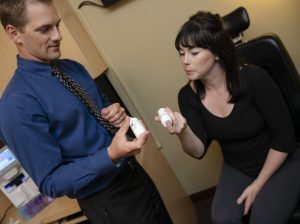 Dry eye syndrome is a chronic lack of sufficient lubrication and moisture on the surface of the eye. It can be caused by many different variables systemically and environmentally. Its consequences range from minor irritation or blur, to the inability to wear contact lenses and an increased risk of corneal inflammation and eye infections.
Dry eye syndrome is a chronic lack of sufficient lubrication and moisture on the surface of the eye. It can be caused by many different variables systemically and environmentally. Its consequences range from minor irritation or blur, to the inability to wear contact lenses and an increased risk of corneal inflammation and eye infections.
Signs and Symptoms of Dry Eye
Persistent dryness, scratchiness, excessive watering and a burning sensation on your eyes are common symptoms of dry eye syndrome. Some people with dry eyes also experience a "foreign body sensation” – the feeling that something is in the eye. If these symptoms happen regularly and are starting to affect your overall eye comfort an appointment with your Optometrist to discuss dry eye and treatment is recommended.
There are currently many different options available and it is difficult to know which is the best for you. Our Optometrists at Doctors Vision Care work hard with all our patients to determine which treatment therapies are most effective in decreasing symptoms and treating underlying causes of dry eyes.
What Causes Dry Eyes?
In dry eye syndrome, the tear glands that moisturize the eye don't produce enough tears, or the tears have a chemical composition that causes them to evaporate too quickly.
Dry eye syndrome has several different variables, the most common are listed below:
- A side effect of many medications, such as antihistamines, antidepressants, certain blood pressure medicines, Parkinson's medications and birth control pills.
- Living or working in a dry, dusty or windy climate with low humidity.
- Insufficient blinking caused by increased screen time at any digital device, such as smartphones, tablets, or computers
- Home or office air conditioning or dry heating systems
- Certain systemic diseases such as lupus, rheumatoid arthritis, rosacea or Sjogren's Syndrome
- Long-term contact lens wear
- Incomplete closure of the eyelids
- Eyelid disease and a deficiency of the tear-producing glands
- Part of the natural aging process, in some relation to the decreased elasticity of lids
- Hormonal changes within the body due to pregnancy or menopause
Recent research suggests that smoking, too, can increase your risk of dry eye syndrome.
There are many different treatments for Dry Eye Syndrome because the underlying causes can be so variable. It is best to contact your Optometrist to find the best treatment plan for you.
